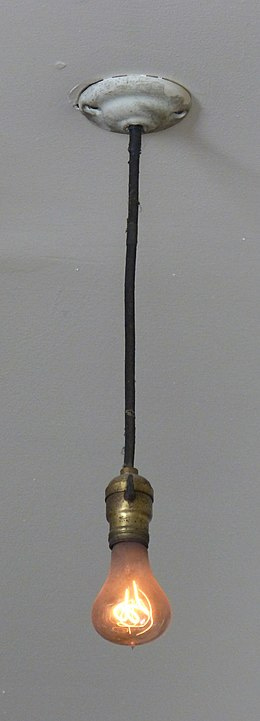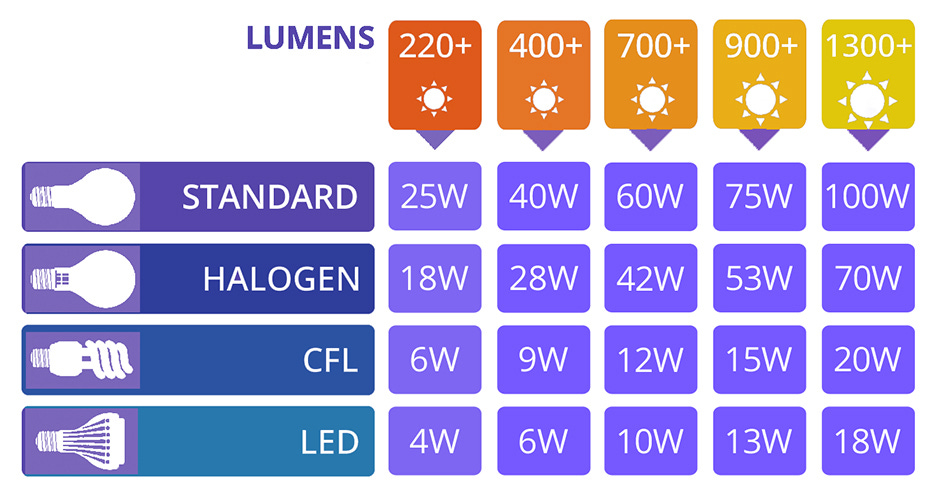Incandescence is the emission of electromagnetic radiation (including visible light) from a hot body as a result of its high temperature. The term derives from the Latin verb incandescere, to glow white.
Source: Wikipedia
Incandescence is a thermal phenomenon but at times it can produce light. If you take iron and toss it into a fire, when you take it out it glows. It is emitting electromagnetic waves that are also in the visible spectrum. Everything that is hot glows in the Infrared spectrum.
If the material has low conductivity or high resistance, it will produce heat which makes the material incandescent. Iron does not resist electricity in fact it is a great conductor. We measure Electrical Resistivity in Ohm-meter or the resistance offered by every meter of the material.

Source: Build Electronic Circuits
The higher the resistivity, the tighter the noose. Thus higher voltage is required to push the charge across which causes heat generation (think of it like friction).
Iron has an electrical resistivity of 0.97X10-8 Ohm-meter or 0.0000000097 Ohm-meter. Wood by comparison has a resistance of 10000 Ohm-meter. Electrical resistance produces heat and if anything is sufficiently hot, it glows.
The problem with wood is that it has a combustion temperature of about 350 C. At that temperature, it will catch fire, so while it will glow, it will burn as well.
The challenge was finding a material with such high resistance that it would glow when electricity passed through it but at the same time a high enough melting/combustion temperature that it would not melt or burst into flames.
Electricity
Benjamin Franklin is often cited as one of the first people to experiment with electricity with the kite-flying experiments in 1767. By 1800 Alessandro Volta has created the first battery. People started experimenting with electricity thanks to the battery.
While Thomas Edison is often credited with the invention of the bulb, he was perhaps the last to stand on the shoulders of several giants.
In 1802, Humphry Davy invented the first electric light. He experimented with electricity and invented an electric battery. When he connected wires to his battery and a piece of carbon, the carbon glowed, producing light. His invention was known as the Electric Arc lamp. And while it produced light, it didn’t produce it for long and was much too bright for practical use.
Over the next seven decades, other inventors also created “light bulbs” but no designs emerged for commercial application. More notably, in 1840, British scientist Warren de la Rue enclosed a coiled platinum filament in a vacuum tube and passed an electric current through it. The design was based on the concept that the high melting point of platinum would allow it to operate at high temperatures and that the evacuated chamber would contain fewer gas molecules to react with the platinum, improving its longevity. Although an efficient design, the cost of the platinum made it impractical for commercial production.
In 1850 an English physicist named Joseph Wilson Swan created a “light bulb” by enclosing carbonized paper filaments in an evacuated glass bulb. And by 1860 he had a working prototype, but the lack of a good vacuum and an adequate supply of electricity resulted in a bulb whose lifetime was much too short to be considered an effective producer of light. However, in the 1870’s better vacuum pumps became available and Swan continued experiments on light bulbs. In 1878, Swan developed a longer lasting light bulb using a treated cotton thread that also removed the problem of early bulb blackening.
Source: Bulb
Then Edison came along with this cotton and linen filament bulb in 1878. It was in 1906 that the patent for the tungsten filament bulb was filed by General Electric. The bulb that went on to light up the world.
The journey of 100 years was to find a filament that would light up enough and last long enough. The search for Tungsten was also to make sure that the light bulb lasts longer.
By the 1920s the bulbs had become so efficient that they were not dying.
The Centennial Light was originally a 30-watt (or 60-watt) bulb, but is now very dim, emitting about the same light as a 4-watt nightlight. The hand-blown, carbon-filament common light bulb was invented by Adolphe Chaillet, a French engineer who filed a patent for this technology. It was manufactured in Shelby, Ohio, by the Shelby Electric Company in the late 1890s; many just like it still exist and can be found functioning.
According to Zylpha Bernal Beck, the bulb was donated to the Fire Department by her father, Dennis Bernal, in 1901. Bernal owned the Livermore Power and Water Company and donated the bulb to the fire station when he sold the company. That story has been supported by firefighter volunteers of that era.
Evidence suggests that the bulb has hung in at least four locations. It was originally hung in 1901 in a hose cart house on L Street, then moved to a garage in downtown Livermore used by the fire and police departments. When the fire department consolidated, it was moved again to a newly constructed City Hall that housed the unified department.
Its unusual longevity was first noticed in 1972 by reporter Mike Dunstan. After weeks of interviewing people who had lived in Livermore all their lives, he wrote “Light Bulb May Be World’s Oldest”, published in the Tri-Valley Herald. Dunstan contacted the Guinness Book of World Records, Ripley’s Believe It or Not, and General Electric, who all confirmed it as the longest-lasting bulb known in existence. The article came to the attention of Charles Kuralt of the CBS-TV program On the Road with Charles Kuralt.
Retired Deputy Fire Chief Tom Bramell wrote a history of the bulb. It is titled “A Million Hours of Service”.

The pendant light at Fire Station #6 in which the bulb is installed.
In 1976, the fire department moved to Fire Station #6 with the bulb; the bulb socket’s cord was severed for fear that unscrewing the bulb could damage it. It was deprived of electricity for only 22 minutes during the transfer, which was made in a specially designed box and with full firetruck escort. An electrician was on hand to install the bulb into the new fire station’s emergency generator. Ripley’s Believe It Or Not stated that the short delay would not mar the bulb’s continuous burning record. Since that move, the bulb has run continuously on an uninterruptible power supply; previously it had only been off the grid for short periods of time (e.g. a week in 1937 for a renovation and the odd power outage). In 2001, the bulb’s 100th birthday was celebrated with a community barbecue and live music.
On the evening of May 20, 2013, the general public witnessed, through a dedicated webcam, that the bulb had apparently burned out. The next morning, an electrician was called in to confirm its status. It was determined that the bulb had not burned out when the dedicated power supply was bypassed, using an extension cord. The power supply was found to have been faulty. Approximately 9 hours and 45 minutes had passed before the light was reestablished.
The bulb is cared for by the Centennial Light Bulb Committee, a partnership of the Livermore-Pleasanton Fire Department, Livermore Heritage Guild, Lawrence Livermore National Laboratories, and Sandia National Laboratories. The Livermore-Pleasanton Fire Department plans to house and maintain the bulb for the rest of its life, regardless of length. When it does go out, they have no plans for it, although Ripley’s Believe it or Not! has requested it for their museum.
Source: Wikipedia
This would have been a massive blow to capitalism. How can you continue to make money if people don’t keep changing their bulbs? And like that, an electric bulb cartel called Pheobus was born.
The Phoebus cartel was an international cartel that controlled the manufacture and sale of incandescent light bulbs in much of Europe and North America between 1925–1939. The cartel took over market territories and lowered the useful life of such bulbs, which falsely claimed to raise their efficiency and output. Corporations based in Europe and the United States, including Osram, General Electric, Associated Electrical Industries, and Philips, incorporated the cartel on January 15, 1925 in Geneva, as Phœbus S.A. Compagnie Industrielle pour le Développement de l’Éclairage (French for “Phoebus plc Industrial Company for the Development of Lighting”). Although the group had intended the cartel to last for thirty years (1925 to 1955), it ceased operations in 1939 with the outbreak of World War II. Following its dissolution, light bulbs continued to be sold at the 1,000 hour life standardized by the cartel.
Source: Wikipedia
Capitalism for the win!
For more than half a century they destroyed the planet through this planned obsolescence which could have been entirely avoided.
Technology Changes
But thankfully technology moved on. Over the years, newer standards of lighting have emerged and as you can see in the chart below, each step has been a move towards greater power efficiency. The amount of light produced by a light source is measured in Lumens. As you can see, the wattage needed or the energy needed to produce the same amount of light has been consistently declining.

Source: Lampsone
The world has been switching to LED for a fairly long time also because LEDs have a longer standard lifespan (50,000 hours) than that of the incandescent bulb. While the lifespan deficit was an engineered catastrophe the efficiency deficit was a technological shortcoming.
Einstein won the Nobel Prize for discovering the photo-electric effect where light is converted to electricity which helps run the entire solar power industry today. The LED is the reverse where electricity is converted to light. Discovered in 1907 by a scientist in Marconi Labs, certain materials like silicon carbide were found to light up when electricity is passed through it.
The incandescent bulb should have been phased out a decade ago. But as I mentioned, Capitalism for the win!
Then last week.
The Department of Energy (DOE) rules around lightbulbs have long been a lightning rod of sorts in American politics. Former president Barack Obama tried to phase out inefficient bulbs, but his successor Donald Trump scrapped the policy. The Biden Administration brought the plan back on track and, starting today (Aug. 1), the sale of energy inefficient lightbulbs will be banned in the US.
A new minimum standard for lightbulbs has been set at 45 lumens—or brightness—per watt. Retailers can’t sell bulbs that don’t meet the criteria, though households can continue using existing bulbs.
Most traditional incandescent and halogen bulbs won’t make the cut.
Source: Quartz
And like that, an era comes to an end.
But wait up, it is not like LEDs are great for the environment. The most common LEDs use Gallium Arsenide Phosphide. Just by hearing the name of that compound you know it is not going to bio-degrade into fertilizer for plants.
So yeah! This is an end of an era to move towards a more efficient lighting solution but also perhaps a more environmentally unfriendly solution when it comes time to lay the LED to rest.

Leave a Reply